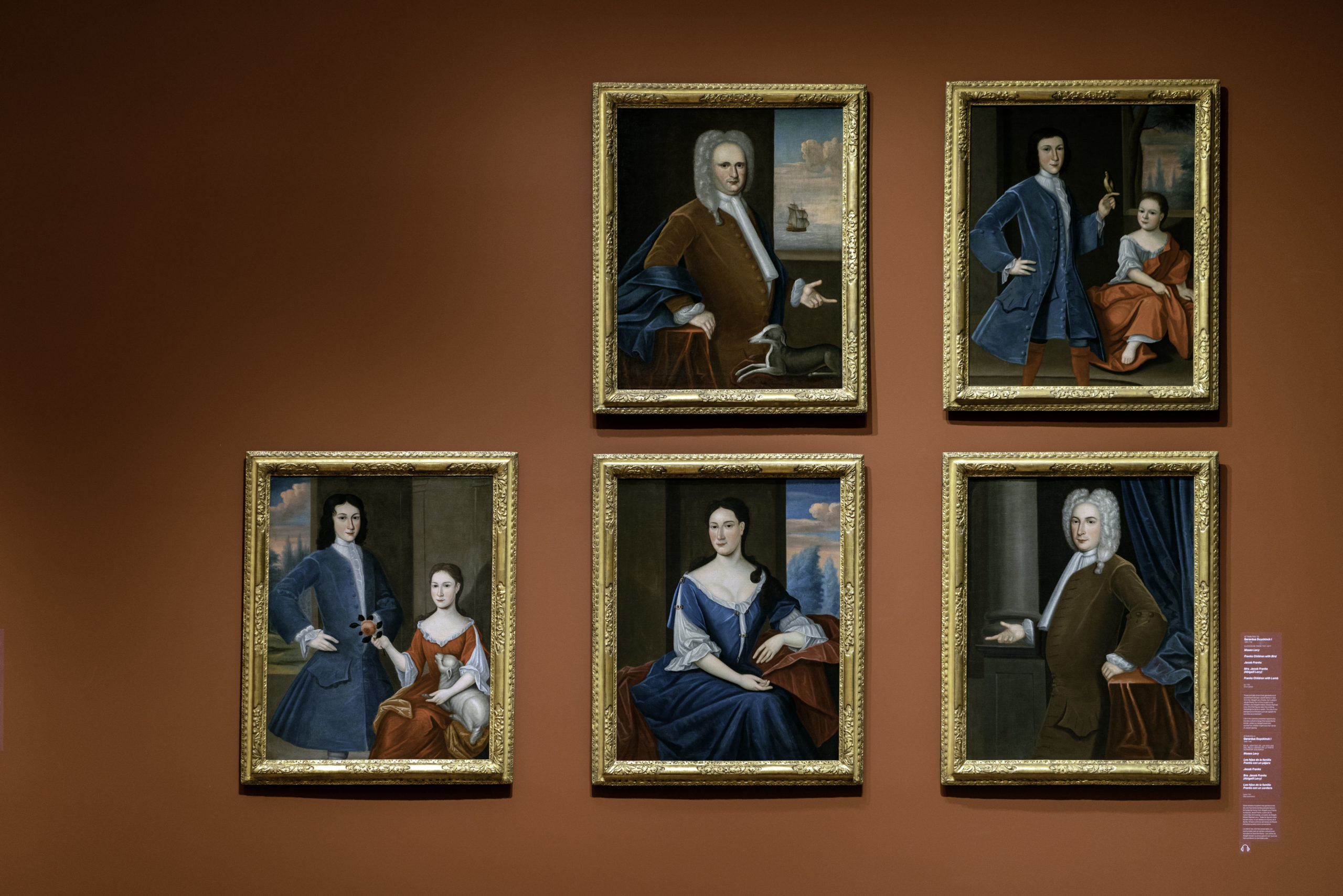Six Portraits of the Levy-Franks family (c. 1735) will be useful in the study of:
- Migration and settlement
- Connections across the Atlantic World
- America before the Revolutionary War
- Race and national identity
- Jewish history in America
By the end of this lesson, students should be able to:
- Discuss the Six Portraits of the Levy-Franks Family as a set of primary documents that links to their specific historical context during the eighteenth century
- Discuss the social and economic context that produced the Levy-Franks’ wealth
- Discuss how the source material for the paintings reflects the aspirations of the family

Gerardus Duyckinck I (attributed), six portraits of the Levy-Franks family (Franks Children with Bird, Franks Children with Lamb, Jacob Franks, Moses Levy, Mrs. Jacob Franks (Abigaill Levy), and Ricka Franks), c. 1735, oil on canvas, Crystal Bridges Museum of American Art (photo: Steven Zucker, CC BY-NC-SA 2.0)
1. Look closely at the paintings
Look closely at Portraits of the Levy-Franks family, c. 1735 (zoomable images, also available for download for teaching)
Questions to ask:
- Describe the paintings. What stands out to you?
- What makes the paintings feel like a group that belongs together?
- What details in the paintings feel like they might be important?
2. Watch the video
The video Six Portraits of the Levy-Franks family is only four and a half minutes long. Ideally, the video should provide an active rather than a passive classroom experience. Please feel free to stop the video to respond to student questions, to underscore or develop issues, to define vocabulary, or to look closely at parts of the painting that are being discussed. Key points, a self-diagnostic quiz, and high resolution photographs with details of the Six Portraits of the Levy-Franks family are provided to support the video.
3. Read about the paintings and their historical context
An expression of status
Having one’s portrait painted was something only the wealthy could afford. By commissioning six portraits of their family, the Levy-Franks were demonstrating their wealth and status in the community of New York City. There were no painters with extensive formal training in the colony, so limners (itinerant artists with little or no formal instruction) were the only artists available to make portraits. The flat and slightly stiff feeling of the paintings reflects the limner’s lack of training in the naturalistic Baroque style popular in Europe.
The paintings were made using British prints as inspiration. Mezzotints (a style of printmaking that creates a wide range of soft tones) from England that copied paintings of the British aristocracy provided the basis for the Levy-Franks portraits, and probably reflected their social aspirations. The portrait of Abigaill Levy-Franks was likely based on a portrait like this one of Princess Anne, with a similar pose and style of dress to the one we see in the painting. The semi-public space in the house where these paintings were hung made their statement of familial wealth and status known to all the family’s visitors.
Jewish in the “New World”
The Levy-Franks were one of a small number of families in New York City who identified as Jewish. By 1730, there were only 75 Jewish families in the city. The Levy-Franks lived in what is now Lower Manhattan, and helped found the Mill Street Synagogue, the first Jewish congregation in North America. Abigaill Levy-Franks’ letters to one of her sons living in London reveal her concern that he keep to his Jewish traditions, including a kosher diet and observance of the holidays and the Sabbath.
While Abigaill was concerned with her son maintaining his Jewish identity, the Levy-Franks portraits do not contain references to Jewishness. This may have been intended to avoid alienating visitors to their home, emphasizing what they had in common with them (wealth and status) rather than their differences.
4. Discussion questions
- The portraits reinforce the wealth and social status of the Levy-Franks family, but also create a strong network between the members of three generations. Looking at the portraits together, how did the artist emphasize family connections and create a unified sense of community?
- Why do you think that the male figures point to Abigaill? What does that say about her status? Is that status surprising?
- Why do you think that the limner borrowed elements from British mezzotints in the Levy-Franks portraits? What messages do those elements send to viewers?
- Do you think these portraits be different if they had been painted in London rather than New York? Why or why not?
- What would be a modern equivalent of the Levy-Franks portraits? What is different between a formal painted portrait and other kinds of portraits?
5. Research questions
- Early portraitists in the American colonies included John Singleton Copley (The Mifflins, Paul Revere, and Henry Pelham), the Freake painter, Lawrence Kilburn, Henry Benbridge, Pieter Vanderlyn, John Smibert, Robert Feke, and Joseph Blackburn. Choose works by two of these artists and compare them to the Levy-Franks portraits. How are they similar? How are they different?
- Modern artists like Kehinde Wiley, Cindy Sherman, Lucian Freud, and Amy Sherald have reinterpreted what portrait painting looks like. Choose two modern portrait artists, and compare a work from each to the Six Portraits of the Levy-Franks Family. How are their messages the same or different? Do they use their materials in the same way?
6. Bibliography
See the series of paintings at the Crystal Bridges Museum of American Art
Learn more about the history of Jewish families in America
Read a history of Jewish merchants in colonial America and their role in the chocolate trade





